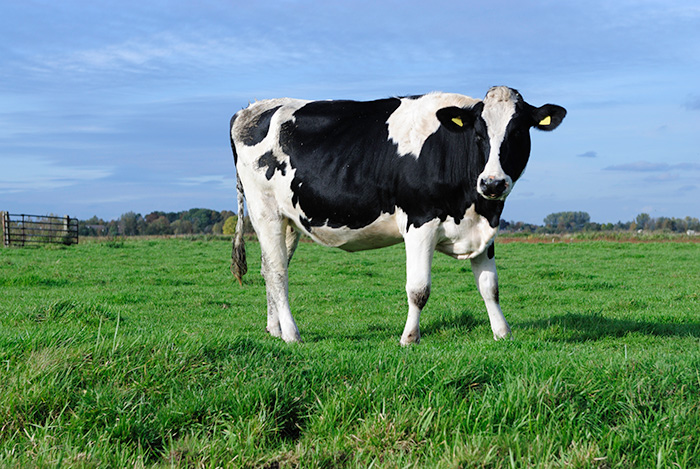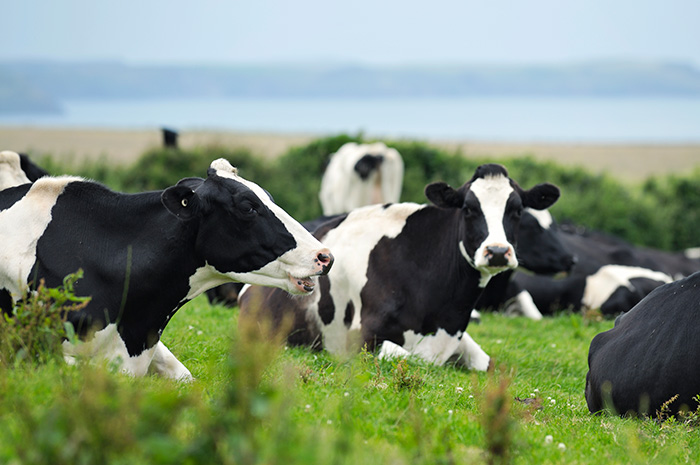The future is notoriously hard to predict. There are so many variables that affect the outlook of the U.S. dairy industry but there are a few constants that you can rely on – demand for animal proteins will continue to grow as the world population increases and dairy farmers will continue to lead the way in efficiency and water productivity.
In 2067 the world’s population is estimated to reach 10.4 billion, with 81% of the people living in Africa or Asia. Increased per capita income worldwide is expected to boost demand for animal source foods. According to the Food and Agriculture Organization (FAO) of the United Nations, even small amounts of animal source foods can improve the nutritional status of low-income households. Meat, milk and eggs provide proteins with a wide range of amino acids as well as micro-nutrients such as iron, zinc, vitamin A, vitamin B12 and calcium, in which many malnourished people are deficient.
Dairy production is currently highly efficient at providing the most nutrition while using the least amount of resources. A report by the researchers Clark and Tillman in 2017 calculated that the production of dairy products uses less land to produce 1 gram of readily edible protein than all other animal products and even some plant products. Worldwide consumption of dairy products averages about 191 pounds per person and is expected to increase to over 262 pounds per person by 2067. This represents a need for an additional production of over 1.3 trillion pounds of milk by 2067. Are dairy farmers up for the challenge? Many experts agree that continued global modernization and adaption of new technologies will grow dairy production at an accelerated rate.

Innovative Dairy Farmers Ready to Meet the Growing Demand
Rosy-Lane Holsteins of Watertown, Wisconsin, is an example of a dairy farm that is using all the tools at their disposal to increase productivity and efficiency. Recognized as the 2020 winner of the U.S. Dairy Center for Innovation Outstanding Dairy Farm Sustainability award, Rosy-Lane has concentrated on genetics, better feed conversion ratios and finding ways to re-use water in the production environment.
“We are focused on how much fat and protein our cows are producing, because that is exactly how we get paid,” said Jordan Matthews, co-owner of Rosy-Lane Holsteins since 2013. “Every pound of milk produced on our farm, we want to make sure that is a saleable pound of milk, not one we have to dump down the drain. You find out quickly that the drain doesn’t pay you very well.”
Udder hygiene and cow health are big factors in reducing the amount of unsaleable milk. Rosy-Lane invested substantially in better genetics and protocols/treatments to reduce mastitis and virtually eliminate antibiotic use. These improvements have helped Rosy-Lane produce 1.7 pounds of milk for every 1 pound of feed for the milking herd. The average U.S. dairy attains 1.5, according to Cornell University. This means that Rosy-Lane produces about 70 more semi-tankers of milk a year using the same inputs as other dairy farms. Another productivity practice Rosy-Lane has implemented is utilizing dried by-products like cottonseed, oat hulls and whey permeate into the cows’ feed.
“A big change that we have zeroed in on was creating an environment where our cows can thrive and live longer,” said Matthews. “Our older cows have a better feed conversion efficiency which equates to more milk product. We want our cows to last at least four lactations and not the two and half which is the breed average in Wisconsin.”
All of these practices are key management tools that will impact dairy farms of the future. Farmers today are expected to produce more with less and the dairy industry is leading the way in productivity.
Combining Profitability with Sustainability and Increased Water Productivity
Researchers and scientists at the Daugherty Water for Food Global Institute and the Department of Animal Science of the University of Nebraska, along with the Twente Water Centre of the University of Twente, Netherlands recently collaborated to produce a report on the changes in water productivity (WP) of U.S. animal products from 1960 to 2016. The goal was to define a clear, concise way to measure and compare the WP of meat and milk production and identify opportunities to improve water efficiencies within the livestock production system.
“Water productivity is a little more intuitive of a parameter because it is the production yield divided by how much water went into producing it,” said Christopher Neale, Ph.D., Director of Research at the Robert B. Daugherty Water for Food Global Institute at the University of Nebraska. “It is the inverse ratio of a water footprint.”
Maximizing the optimal use of all inputs will be critical in the future as the agriculture industry strives to provide solutions to environmental issues, including water use. Water is a precious resource and taking time to evaluate new ways to eliminate water waste and institute best management practices are key to increasing your farm’s WP. Little details like re-using boot wash water to maintaining watering founts can affect your WP and your profitability. Research shows that approximately 1% of a dairy cow’s water footprint is the 30 to 50 gallons of fresh water consumed daily.
“The biggest use of fresh groundwater on the farm is our plate cooler,” said Matthews. “We use the 50-degree groundwater to cool the milk down to about 65-70 degrees. That water then goes to an old milk tanker that holds about 6,500 gallons and is reused in multiple ways to reduce our freshwater consumption. We estimate that our water re-use plan has reduced our manure hauling by about 1.5 million gallons a year.”
According to the report, in 2016 there were 47% fewer dairy cows producing 73% more milk than in 1960. During this period, the same volume of water was used to produce 400% more milk (weight-measured).
“The WP of all livestock products – beef, pork, chicken, turkey, milk and eggs – increased considerably from 1.8 times for beef to 5.1 times for milk,” said Mesfin Mekonnen, Ph.D., Assistant Professor at the Department of Civil, Construction and Environmental Engineering, the University of Alabama and one of the lead authors of the research study. “In evaluating opportunities to increase WP, one area that we examined in depth was utilizing distiller’s grains and other crop by-products as substitutes for corn and soybeans. This research will help set benchmarks and identify critical factors affecting WP to help meet the growing global demand for livestock products.”

No Productivity Detail is Too Small to Overlook – Make Sure to Consider Your Cow’s Fresh Water Requirements
Providing clean, fresh water on demand is a core management practice but many dairy farms may be lulled into a sense of complacency when it comes to their watering system. In general, dairy cows make about 24 trips to the water trough throughout the day and will drink around 1.5 gallons of water per trip. All total a single cow will spend about 12 to 16 minutes a day drinking water. Keeping the water clean and flowing at the proper rate, maintaining optimal water temperature, providing adequate space for all cows to drink comfortably are all crucial elements that influence how much your cows are drinking and producing which in turn, affects your efficiency. Even if your old concrete or bowl troughs are still in good working condition, consider the energy and cost savings of utilizing new founts or troughs.
“For many dairy farmers it is not top of mind to cost analyze your automatic watering system,” said Robert Amundson, President and CEO at Ritchie Industries, Inc. “There are so many complex factors that affect your production, but it is important to consider the maintenance costs, longevity, reliability and durability of your founts. If you don’t have clean, fresh water on demand, it can grind your production to a halt. For 100 years, Ritchie has been made in America and we produce the finest, energy efficient founts in the industry. Our OmniMaster series is the latest in large herd innovation with a newly designed high-capacity drain to maintain the cleanliness of the fount. Every single Ritchie fount meets all Grade A dairy requirements, our poly units are 75% more efficient that comparable concrete units and we offer several models that may qualify for utility incentives in several states. It all adds up to a more efficient and clean drinking environment. You can find our red and yellow founts in some of the top producing dairy farms in the country, including Rosy-Lane Holsteins.”
Ritchie Industries is headquartered in Conrad, Iowa, and was the first company to patent the automatic water valve in 1921. Ritchie has manufactured and sold over 3 million units globally.
The Future is Bright
Research continues to reveal how effective and efficient the dairy industry is at producing high quality food products that meet the nutritional needs of people everywhere. As we gaze into the crystal ball, new technologies, genomic advancements, shared sustainability knowledge and emerging discoveries are coming into focus for the global dairy industry. We may not be able to anticipate all that the future holds, but one thing is certain – dairy farmers are primed to meet the challenge.
For more information visit:
Ritchie Industries | RitchieFount.com
Daugherty Water for Food Global Institute at the University of Nebraska | waterforfood.nebraska.edu
Rosy-Lane Holsteins | www.RosyLane.weebly.com
U.S. Dairy Center for Innovation | www.usdairy.com/sustainability
Journal of Dairy Science | Invited review: Learning from the future—A vision for dairy farms and cows in 2067 - Journal of Dairy Science
PHOTOS: iStock.




